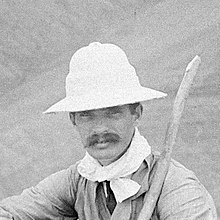John Smith Flett
Sir John Smith Flett (born June 26, 1869 in Kirkwall , Orkney , † January 26, 1947 in Ashdon , Essex ) was a British geologist .
Life
He studied science at the University of Edinburgh with a master's (MA) and bachelor's (B. Sc.) Degree in 1892 and then medicine with a Bachelor of Medicine (BM) and Master of Surgery (CM) degree in 1894. He practiced briefly as Medic, but turned (as he became increasingly deaf) to geology in 1895 as an assistant to James Geikie (1839-1915) at the University of Edinburgh. He became a lecturer in petrology and also taught geology at other Edinburgh institutions such as the School of Forestry and Heriot Watt College. He examined the Old Red Sandstone of Orkney and its volcanic intrusions, for which he received a D. Sc. from Edinburgh University. In 1901 he became a petrograph of the Geological Survey. In 1911 he became assistant to the director of the Geological Survey of Scotland. From 1920 he was director of the Geological Survey for fifteen years, whose move from Piccadilly to South Kensington to the newly opened Geological Museum he organized in 1935. In the same year he retired.
As a petrograph, he contributed to 30 memoirs of the Geological Survey, particularly for the areas of Scotland and South West England. He also wrote a history of the Geological Survey.
He was a Fellow of the Royal Society since 1913 and of the Royal Society of Edinburgh since 1900 . In 1935 he received the Wollaston Medal from the Geological Society of London. In 1917 he received the Bolitho Medal from the Geographical Society of Cornwall. In 1918 he received an OBE and in 1925 KBE .
With Tempest Anderson (1846–1913) he investigated the volcanic rocks of the Montagne Pelée and Soufrière volcanoes (Guadeloupe) in the Caribbean.
He was married to Mary Jane Meason, whose sister was married to Flett's successor as director of the Geological Survey, Edward B. Bailey (1881-1965). Flett had two sons and two daughters.
Since 1972 the Flett Crags bear his name, rocky outcrops in the Shackleton Range in the East Antarctic Coatsland.
Fonts
- with JB Hill: Geology of the Lizard and Meneage, HM Stationery Office, 2nd edition 1946
- with Marion Newbigin: James Geikie, the man and the geologist, Edinburgh 1917
- The first hundred years of the Geological survey of Great Britain, London, HM Stationery Office 1937
Web links
| personal data | |
|---|---|
| SURNAME | Flett, John Smith |
| BRIEF DESCRIPTION | British geologist |
| DATE OF BIRTH | June 26, 1869 |
| PLACE OF BIRTH | Kirkwall , Orkney |
| DATE OF DEATH | January 26, 1947 |
| Place of death | Ashdon , Essex |
